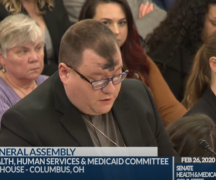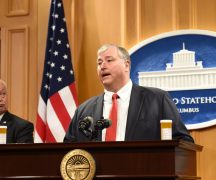BY SUSAN TEBBEN
The Ohio Department of Health said new COVID-19 guidance for schools as they plan for a new school year will include safety recommendations, but no mandate for mask-wearing, even for the unvaccinated.
In a press call on Monday, Dr. Bruce Vanderhoff, chief medical officer for the ODH, said guidelines would be released on the state’s coronavirus-centered web page no later than Tuesday.
He said the recommendations for school districts and parents come as cases increase due to the delta variant, and vaccination rates across the state stagnate.
COVID-19 vaccines simply offer the best protection against COVID-19, followed by masks with layered safety measures like social distancing.
– Bruce Vanderhoff, chief medical officer for the Ohio Department of Health
The guidance, Vanderhoff said, focuses on three layers of protection for schools as they begin reopening post-summer break.
- Vaccinations for staff and eligible students
- Consistent mask-wearing by unvaccinated individuals indoors, and outdoors when social distancing isn’t possible
- Additional measures such as improved building ventilation, social distancing and hand-washing measures
The guidance does not include any requirements or enforcements, because the language stands as a “strong recommendation,” though they are backed by scientific studies, according to the ODH.
“While there are no mandates associated with this guidance, we believe that the recommendations we are issuing are essential to the health of Ohio’s youth, and the success of the coming school year,” Vanderhoff said.
The American Academy of Pediatrics updated their school-opening recommendations recently, encouraging a “layered approach”including mask-wearing for anyone older than age 2.
Dr. Patty Manning-Courtney, chief of staff at Cincinnati Children’s, also participated in the press call, and said much of the safety measures are not up to the children, especially those younger than 12 who aren’t eligible for the vaccine.
“I don’t want to see the day where somebody under age 12 was infected because someone in their life chose not to be vaccinated or chose not to wear a mask,” Manning-Courtney said. “That would be a sad day.”
As for returning children to school with mask recommendations, the doctors said children who learned to wear a mask last year can easily be taught to wear them again, with the reminder that they are protecting friends and teachers along the way.
“I think children are very malleable and much more adaptable than us adults sometimes. I think it’s how you present it to them,” said Dr. Shefali Mahesh, medical staff president and associate chair for the department of pediatrics at Akron Children’s Hospital.
Mahesh said she’s been impressed at the motivational impact going back to school has had on her patients and her own children. She’s also chosen to rephrase the pandemic as one of the many “vaccine preventable” diseases in existence.
“To me that’s very powerful, because we’ve seen the impact that vaccinations have had in preventing so many long-term problems, from measles and polio and things like that,” Mahesh said.
Vanderhoff wouldn’t comment on the potential impact of legislation recently signed into law by Gov. Mike DeWine that bans any requirement for vaccines without full FDA approval (which would include the COVID-19 vaccine, as it only has emergency approval currently) by K-12 schools and colleges.
“Speculating about what could happen if people choose not to apply our recommendations is really beyond my role,” Vanderhoff said.
DeWine was more resolute during an unrelated Monday press conference, when asked about mask mandates in schools.
“I do not believe I have the ability today to mandate that,” DeWine said.
He added that there is no “appetite” for a mask mandate in the state.
“It is clear that we will need to let this decision be made by the parents and this decision be made by the schools,” DeWine said.
Some schools across the state have instituted their own mask regulations, including Columbus City Schools and several in Northeast Ohio.
***
Also from Ohio Capital Journal:
DeWine says he didn’t know about alleged $4.3m bribe of utility regulator he appointed
Gov. Mike DeWine distanced himself Monday from a utility regulator he appointed who was accused last week of accepting millions in bribes from FirstEnergy Corp.
FirstEnergy said in a court filing last week that it paid Randazzo $22 million in consulting fees in the decade leading up to his appointment as chairman of the Public Utilities Commission of Ohio.
This includes a $4.3 million payment, sent shortly before DeWine appointed Randazzo in early 2019, to hand down rulings favorable to the company. The company was under no legal obligation to make the payment, the court filing states.
Randazzo has not been charged with a crime.
DeWine, answering questions on the filing for the first time, said while he didn’t know about the $4.3 million payment, “everybody” knew that Randazzo worked for FirstEnergy during the appointment process.
“I knew he worked for FirstEnergy,” DeWine said. “What I knew was the relationship was over with, that would have been the important thing to me. Whether or not it had been six months or whatever period of time it had been. Everybody knew Sam Randazzo had worked for FirstEnergy, so it wasn’t an issue. My understanding was that relationship had been terminated.” READ MORE
Feds and states not taking radioactivity from fracking seriously, environmental group says
Fracking might be an economic boon to some landowners in depressed sections of Eastern Ohio, Western Pennsylvania and much of West Virginia. But federal and state officials are doing little to protect citizens from the radiation hazards posed by the process, a new report says.
For example, a solution containing substances such as Radium-226 in concentrations 300 times federal drinking water standards is spread on Ohio roads and there are no federal or state regulations to stop the practice, the report by the Natural Resources Defence Councilsays.
After their application to icy roads, it’s not hard to see how toxic substances can run off into streams. From there, who knows?
Titled “A Hot Fracking Mess: How the Lack of Regulation of Oil and Gas Production Leads to Radioactive Waste in Our Water, Air, and Communities,” the report details the many ways that fracking, or “hydraulic fracturing,” produces toxins. READ MORE





